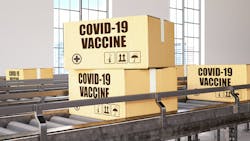COVID Vaccine Moves to the Front of the Supply Chain
Editors Note: Over the course of this week, Machine Design will be sharing a series of articles addressing the development and distribution of the COVID-19 vaccine—and the obstacles surmounted along the way. Be sure to check out the other installments below:
- Manufacturers Were on Point in the Race to a Vaccine
- Speed Bumps on the Road to Delivering COVID Vaccines
- Global Manufacturers Fine-Tune Strategies
- Thanks for Sharing: Reusable Open Source Hardware Respirators
As the mass distribution of the COVID-19 vaccine continues, the world’s supply chains and transportation networks are being stretched and taxed to new limits. The question is, what will this mean for the world’s supply chains and what can procurement professionals do to ensure good levels of supply during this disruptive period? In an interview, Joe Vernon, Capgemini’s supply chain analytics and transformation practice lead. Here are his top observations and some advice on how to navigate the disruption.
Q: Why do buyers need to know about the impact of the vaccine distribution on the supply chain and the transportation networks that support it?
Vernon: As the vaccine distribution is underway, there will be disruptions to the supply chain. For instance, shipping capacity is one element companies should be considering as well as cold chain storage capacity. It appears for the most part that additional freezers have been acquired to create capacity for the vaccines, but parcel shipping capacity has seen some restrictions. Any carrier that's been allocated to transport the vaccine will treat that vaccine as their top priority and that may conflict with the needs of businesses. Items like syringes and vaccination kits would possibly show some scarcity during peak vaccine distribution.
Q: Do we have any historical comparisons to this situation, or is it completely unprecedented?
Vernon: Every year 150 million doses of flu vaccine are distributed. However, these three factors make this effort unique:
- The temperature requirements of some of the vaccines are extreme.
- COVID-19 has greatly amplified the number of ecommerce and online orders. (According to Capgemini research, 48% of consumers have shopped more online this holiday season than ever before), which has in turn occupied historical levels of parcel shipping capacity. (Adobe Analytics projects 33% more online shopping in 2020 versus 2019.)
- As the COVID vaccine is being released, traditional flu vaccines are also being shipped—a phenomenon that will put 100 million doses of vaccine into the supply chain. We've already seen shipping restrictions and elongated ship windows put in place by parcel carriers based on the holiday demand and leaving some capacity to handle vaccines.
Q: What are some of the key impacts that adding vaccine transport to the equation will have on the delivery and arrival of items across the supply chain?
Vernon: Adding vaccine distribution to the supply chain equation could result in delays in delivery of items. For example, some retailers have been capped at how many orders they can ship during the holiday season, coupled with parcel carriers cutting off dates for holiday deliveries that are roughly the same as last year—but when you shop online you can see normal shipping windows of three to five days now go to one to three weeks, in some cases. However, the strain on the last-mile has encouraged shoppers to use other fulfillment options like curbside pickup and instore pickup of orders.
Q: How can procurement professionals manage these new constraints?
Vernon: Amid this uncertainty, resilience is the new supply chain imperative. Across industries, there is growing recognition that managing supply chains for maximum efficiency hampers companies’ ability to respond to risk events. And the frequency of such disruptions is rising, with a recent McKinsey Global Institute survey showing that companies now expect severe supply chain disruptions every 3.7 years. Other good tips for buyers as we head into 2021:
- Economic order quantities (EOQ) should be reexamined.
- Maximizing “lean” may not be the best approach to managing disruption.
- Avoid geographic concentration.
- Push for visibility of your network and related networks.
- Deploy artificial intelligence (AI) and predictive analytics for risk and monitoring shipping capacity and raw material availability.
- Utilize smart contracting and blockchain to streamline the procurement process.
Q: As we look ahead through 2021, what else should companies be thinking about in terms of vaccine and other supply chain issues for the year ahead?
Vernon: Globalization is not a fixed, stable construct. Awareness of disruptors comes from enhancing your data feeds and using AI to detect potential risks. You can do this yourself or subscribe to a service.
